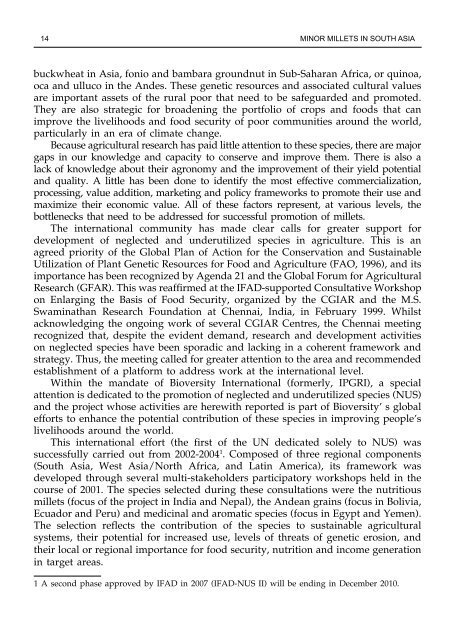Minor millets in South Asia: learnings from IFAD-NUS project in India ...
Minor millets in South Asia: learnings from IFAD-NUS project in India ...
Minor millets in South Asia: learnings from IFAD-NUS project in India ...
You also want an ePaper? Increase the reach of your titles
YUMPU automatically turns print PDFs into web optimized ePapers that Google loves.
14 <strong>M<strong>in</strong>or</strong> Millets <strong>in</strong> south AsiA<br />
buckwheat <strong>in</strong> <strong>Asia</strong>, fonio and bambara groundnut <strong>in</strong> Sub-Saharan Africa, or qu<strong>in</strong>oa,<br />
oca and ulluco <strong>in</strong> the Andes. These genetic resources and associated cultural values<br />
are important assets of the rural poor that need to be safeguarded and promoted.<br />
They are also strategic for broaden<strong>in</strong>g the portfolio of crops and foods that can<br />
improve the livelihoods and food security of poor communities around the world,<br />
particularly <strong>in</strong> an era of climate change.<br />
Because agricultural research has paid little attention to these species, there are major<br />
gaps <strong>in</strong> our knowledge and capacity to conserve and improve them. There is also a<br />
lack of knowledge about their agronomy and the improvement of their yield potential<br />
and quality. A little has been done to identify the most effective commercialization,<br />
process<strong>in</strong>g, value addition, market<strong>in</strong>g and policy frameworks to promote their use and<br />
maximize their economic value. All of these factors represent, at various levels, the<br />
bottlenecks that need to be addressed for successful promotion of <strong>millets</strong>.<br />
The <strong>in</strong>ternational community has made clear calls for greater support for<br />
development of neglected and underutilized species <strong>in</strong> agriculture. This is an<br />
agreed priority of the Global Plan of Action for the Conservation and Susta<strong>in</strong>able<br />
Utilization of Plant Genetic Resources for Food and Agriculture (FAO, 1996), and its<br />
importance has been recognized by Agenda 21 and the Global Forum for Agricultural<br />
Research (GFAR). This was reaffirmed at the <strong>IFAD</strong>-supported Consultative Workshop<br />
on Enlarg<strong>in</strong>g the Basis of Food Security, organized by the CGIAR and the M.S.<br />
Swam<strong>in</strong>athan Research Foundation at Chennai, <strong>India</strong>, <strong>in</strong> February 1999. Whilst<br />
acknowledg<strong>in</strong>g the ongo<strong>in</strong>g work of several CGIAR Centres, the Chennai meet<strong>in</strong>g<br />
recognized that, despite the evident demand, research and development activities<br />
on neglected species have been sporadic and lack<strong>in</strong>g <strong>in</strong> a coherent framework and<br />
strategy. Thus, the meet<strong>in</strong>g called for greater attention to the area and recommended<br />
establishment of a platform to address work at the <strong>in</strong>ternational level.<br />
With<strong>in</strong> the mandate of Bioversity International (formerly, IPGRI), a special<br />
attention is dedicated to the promotion of neglected and underutilized species (<strong>NUS</strong>)<br />
and the <strong>project</strong> whose activities are herewith reported is part of Bioversity’ s global<br />
efforts to enhance the potential contribution of these species <strong>in</strong> improv<strong>in</strong>g people’s<br />
livelihoods around the world.<br />
This <strong>in</strong>ternational effort (the first of the UN dedicated solely to <strong>NUS</strong>) was<br />
successfully carried out <strong>from</strong> 2002-2004 1 . Composed of three regional components<br />
(<strong>South</strong> <strong>Asia</strong>, West <strong>Asia</strong>/North Africa, and Lat<strong>in</strong> America), its framework was<br />
developed through several multi-stakeholders participatory workshops held <strong>in</strong> the<br />
course of 2001. The species selected dur<strong>in</strong>g these consultations were the nutritious<br />
<strong>millets</strong> (focus of the <strong>project</strong> <strong>in</strong> <strong>India</strong> and Nepal), the Andean gra<strong>in</strong>s (focus <strong>in</strong> Bolivia,<br />
Ecuador and Peru) and medic<strong>in</strong>al and aromatic species (focus <strong>in</strong> Egypt and Yemen).<br />
The selection reflects the contribution of the species to susta<strong>in</strong>able agricultural<br />
systems, their potential for <strong>in</strong>creased use, levels of threats of genetic erosion, and<br />
their local or regional importance for food security, nutrition and <strong>in</strong>come generation<br />
<strong>in</strong> target areas.<br />
1 A second phase approved by <strong>IFAD</strong> <strong>in</strong> 2007 (<strong>IFAD</strong>-<strong>NUS</strong> II) will be end<strong>in</strong>g <strong>in</strong> December 2010.

















